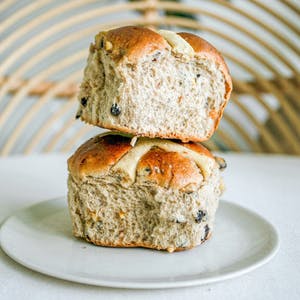The History Of The Hot Cross Bun
With Easter just around the corner, there’s a good chance you’ve indulged in a hot cross bun (or two, in our case!).

But as you prep a generous slather of butter and your cup of tea, have you ever wondered how the hot cross bun came to be?
Most of us would’ve grown up with hot cross buns magically appearing around Easter time, the smell of spices wafting through the kitchen as they were toasted and buttered for a reverent Good Friday treat. And while hot cross buns have long been synonymous with the Christian holiday, baked goods marked with crosses can be traced back much further.
It’s said that the Saxons baked and ate buns marked with crosses to celebrate the spring equinox and honour Eostre – the Germanic goddess of fertility, springtime and light. Often depicted surrounded by blooming flowers and baby animals, it’s easy to see why her name is only a hop-skip away from the holiday many of us celebrate today.
Cakes and buns marked with crosses were also baked by Druids, Phoenicians, Greeks and Romans to honour Diana, goddess of the hunt and the moon. These buns were often marked with lines to resemble the horns of an ox or deer, or a cross to denote the four phases of the moon.
As for the hot cross bun we know today? There’s a few theories, the most renowned being that of St. Albans, England. It’s believed that a 14th-century monk by the name of Brother Thomas Rodcliffe baked a simple spiced bun and distributed them among the local poor on Good Friday. From there, hot cross buns became forever intertwined with Christianity and the Commonwealth. Folklore told that buns baked on Good Friday would never go mouldy (don’t try this at home!), and that keeping one from the batch for medical purposes throughout the year would protect the household from ill health. Other superstitions told of hot cross buns protecting sea voyagers from shipwreck, and protecting houses from fire if buns were hung in the kitchen.
The mysticism around these buns was so great, that Elizabeth I of England decreed that they only be baked for burials, Good Friday and Christmas. In what will be relatable for any foodie, the deliciousness of these now-forbidden buns merely forced their baking into domestic kitchens, where they continued to be enjoyed in secret.
The 21st-century hot cross bun has come a long way from its ‘one a penny, two a penny’ days, with the humble combination of spice and fruit constantly up for experimentation and reinterpretation. Producers like Paddy the Baker, Brasserie Bread and This Is Us offer everything from traditional Irish hot cross buns to artisan-baked buns packed with warming ginger and cinnamon. Fancy something a little more daring this long weekend? The duo behind Tokyo Lamington have dreamt up the ultimate Easter Pack, with three yuzu (yes, yuzu!) hot cross buns alongside three bespoke hot cross lamingtons. It’s a bold choice, but one that’s sure to delight.
Whether you’re baking your own or letting a local producer master the art for you, there’s nothing better than a warm, toasted hot cross bun this holiday season.
Stay Up To Date
Sign up to receive our monthly newsletter with upcoming events, producer-in-focus, food news and so much more.


